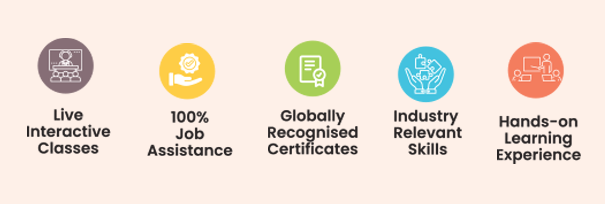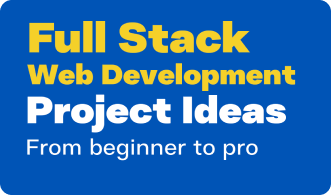Introduction
In today’s fast-paced tech world, full stack development is a highly desirable skill set. Developers who can handle both frontend and backend tasks are in high demand across industries. However, to thrive in this field, it’s crucial to choose the right tech stack—a combination of technologies that work together to build applications efficiently and effectively.

This blog explores the top tech stacks you should consider learning in 2025 and beyond. Whether you’re a beginner or an experienced developer, mastering these tech stacks will give you a competitive edge.
MERN Stack (MongoDB, Express, React, Node.js)
The MERN stack is one of the most popular tech stacks for full stack development. It’s known for its JavaScript-based technologies that streamline both frontend and backend development.
Components
· MongoDB: A NoSQL database that stores data in a flexible, JSON-like format.
· Express: A lightweight web framework for handling backend logic and API development.
· React: A powerful frontend library for building interactive user interfaces.
· Node.js: A runtime environment that allows JavaScript to run on the server side.
Why Learn the MERN Stack?
· Simplifies development by using JavaScript throughout the entire application.
· Ideal for building scalable, high-performance single-page applications (SPAs).
· Widely used by companies like Facebook, Netflix, and Airbnb.
MEAN Stack (MongoDB, Express, Angular, Node.js)
The MEAN stack is similar to the MERN stack but uses Angular instead of React for frontend development. Angular is a TypeScript-based framework developed by Google, offering a structured and feature-rich approach to building web apps.
Components
· MongoDB: NoSQL database for scalable storage.
· Express: Backend framework for managing server-side operations.
· Angular: A frontend framework that supports two-way data binding and reactive programming.
· Node.js: Server-side runtime environment.
Why Learn the MEAN Stack?
· Suitable for large, complex enterprise applications.
· Angular’s robust features and tools make it easier to develop maintainable code.
· Trusted by enterprises such as Google and IBM.

LAMP Stack (Linux, Apache, MySQL, PHP)
The LAMP stack is a time-tested tech stack known for powering millions of websites and web applications. It’s particularly popular for developing dynamic content-driven sites.
Components
· Linux: The operating system that serves as the foundation of the stack.
· Apache: A widely-used web server.
· MySQL: A relational database for managing structured data.
· PHP: A server-side scripting language designed for web development.
Why Learn the LAMP Stack?
· Open-source and cost-effective.
· PHP is highly compatible with content management systems (CMS) like WordPress, Joomla, and Drupal.
· Ideal for building blogs, e-commerce sites, and data-driven platforms.
JAMstack (JavaScript, APIs, Markup)
JAMstack is a modern architecture designed to improve the performance, scalability, and security of web applications. It emphasizes pre-rendered static content and dynamic interactions through APIs.
Components
· JavaScript: Handles client-side interactivity.
· APIs: Enable communication with backend services.
· Markup: Static HTML content generated by static site generators (e.g., Gatsby, Next.js).
Why Learn JAMstack?
· Enhances application speed and performance.
· Reduces server costs by serving static files through CDNs.
· Popular for content-heavy websites, including documentation sites and marketing pages.
Ruby on Rails Stack
Ruby on Rails (often referred to as Rails) is a full stack web development framework that emphasizes simplicity and productivity. It’s known for its “convention over configuration” approach, which helps developers focus on application logic rather than boilerplate code.
Components
· Ruby: A dynamic programming language.
· Rails: A framework that simplifies tasks such as database management and routing.
· PostgreSQL: Commonly used as the database for Rails applications.
Why Learn Ruby on Rails?
· Developer-friendly syntax and productivity.
· Rapid prototyping capabilities.
· Used by companies like GitHub, Shopify, and Airbnb.

.NET Stack (ASP.NET, SQL Server, C#)
The .NET stack, developed by Microsoft, is widely used for building enterprise-level applications. It supports both web and desktop development, making it a versatile choice for developers.
Components
· ASP.NET: A web framework for building dynamic web apps.
· SQL Server: A relational database management system.
· C#: A programming language designed for performance and scalability.
Why Learn the .NET Stack?
· Excellent support for enterprise solutions.
· Integration with Microsoft’s ecosystem, including Azure cloud services.
· Ideal for secure, high-performance applications.
Python-Django Stack
Python-Django is a popular tech stack for building scalable and secure web applications. Django is a high-level framework that simplifies many backend tasks.
Components:
· Python: A versatile programming language known for readability and efficiency.
· Django: A backend framework that offers built-in security and rapid development tools.
· PostgreSQL or MySQL: Common databases used with Django.
Why Learn Python-Django?
· Excellent for data-driven applications, including those in AI and machine learning.
· Emphasizes security features, including protection against SQL injection and cross-site scripting.
· Used by companies like Instagram and Pinterest.c
Which Tech Stack Should You Choose?
Choosing the right tech stack depends on your career goals and project requirements. Here are some tips to help you decide:
· MERN or MEAN Stack: Ideal for JavaScript enthusiasts who want to build dynamic, full-stack web apps.
· LAMP Stack: Best for developers working with traditional CMS platforms or PHP-based applications.
· JAMstack: Great for developers focused on performance, scalability, and static content delivery.
· Ruby on Rails: Suitable for startups and rapid prototyping projects.
· .NET Stack: Ideal for those targeting enterprise solutions and Microsoft technologies.
· Python-Django: Perfect for data-heavy and secure applications.
Career Opportunities with Full Stack Tech Stacks
Mastering any of these tech stacks opens up numerous career opportunities. Full stack developers are in high demand, with salaries ranging from ₹10-20 LPA in India and $80,000-$150,000 globally. Companies like Google, Amazon, Microsoft, and various startups seek developers proficient in modern tech stacks to build and maintain their applications.
At Grras Solutions, we offer comprehensive training programs in full stack development, including hands-on projects, expert mentorship, and placement support. Join us to stay ahead of industry trends and unlock your potential as a full stack developer.
Conclusion
Choosing the right tech stack is essential for success in full stack development. Whether you prefer JavaScript-based stacks like MERN and MEAN, traditional stacks like LAMP, or modern approaches like JAMstack, there’s a stack suited to your goals. By mastering one or more of these tech stacks, you can future-proof your career and take advantage of the growing demand for full stack developers.
Start your journey with Grras Solutions and become a 10X developer ready to build the digital world of tomorrow!





 Whatsapp us
Whatsapp us Call us
Call us





